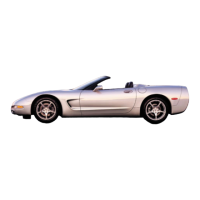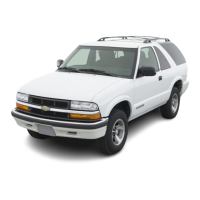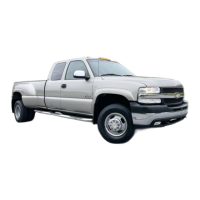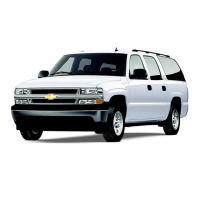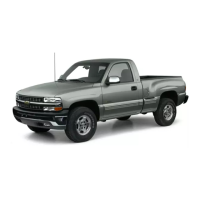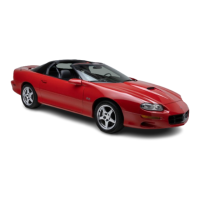
Do you have a question about the Chevrolet 2001 Camaro and is the answer not in the manual?
| Brand | Chevrolet |
|---|---|
| Model | 2001 Camaro |
| Category | Automobile |
| Language | English |
Explains safety cautions, symbols, and their meanings.
Information about adjusting vehicle seats and seatbacks for comfort and safety.
Guidance on proper safety belt usage and things to avoid for effective protection.
Detailed instructions for adults on wearing lap-shoulder belts correctly.
Explanation of how the vehicle's air bag system works and its safety features.
Importance of buckling up rear seat passengers and proper belt usage.
Guidance on child safety restraints and their proper use in the vehicle.
Overview of different types of child restraint systems available.
Proper safety belt usage for children who have outgrown booster seats.
Using the remote transmitter to lock/unlock doors and trunk.
How to arm and disarm the vehicle's anti-theft alarm system.
Procedures for starting automatic and manual transmissions.
Explanation of shift lever positions and operation of automatic transmission.
How to operate the 5-speed manual transmission, including shift patterns.
Information on carbon monoxide hazards and what to do if exhaust is suspected.
How to use cruise control and safety precautions.
Step-by-step guide to setting and using cruise control.
Overview of gauges and indicators on the instrument panel.
Explanation of vehicle warning lights, gages, and indicators.
Meaning of the air bag readiness light and what to do if it stays on.
What the brake warning light signifies and immediate actions.
Meaning of ABS warning light and normal system checks.
How ASR limits wheel spin and its effect on vehicle performance.
When the low traction light indicates ABS or ASR system activity.
Meaning of the malfunction indicator lamp and its relation to emissions control.
Actions to take if the malfunction indicator lamp is flashing to prevent damage.
Meaning of the low oil light and actions to take.
Meaning of the service vehicle light and potential vehicle problems.
What the check gages light indicates and how to check instrument panel gages.
Meaning of the reduced engine power light and performance implications.
How to operate heating, air conditioning, and ventilation systems.
Operating the air conditioner for cooling, including MAX and A/C settings.
General information on operating the vehicle's audio system.
Features of the Monsoon stereo with CD player and automatic tone control.
Key principles and techniques for safe and defensive driving.
The dangers of alcohol impairment and its effects on driving ability.
How brakes, steering, and accelerator systems work together.
Explanation of perception and reaction time in braking action.
How the ABS system prevents skidding and what warning lights mean.
Proper technique for using anti-lock brakes and what to expect.
How ASR limits wheel spin and its effect on vehicle performance.
Information on steering systems and how to maintain control.
How steering can be effective in emergency situations.
Tips for safely passing other vehicles on two-lane roads.
Understanding situations that can lead to loss of vehicle control.
How to avoid skids and what to do if the vehicle skids.
Tips and precautions for driving safely at night.
How rain and wet roads affect driving and how to maintain traction.
Understanding hydroplaning and how to avoid it.
How to drive safely in slippery conditions with snow or ice.
Understanding vehicle weight limits and proper cargo distribution.
Essential safety rules and tips for towing a trailer with the vehicle.
Tips for handling and driving with a trailer attached.
Steps and safety precautions for jump starting a vehicle.
Steps for removing a flat tire and installing the spare tire.
Recommended fuel types and octane ratings for optimal performance.
Safety precautions and procedure for refueling the vehicle.
Information regarding engine oil and its importance.
How to check engine oil level accurately when the engine is warm.
Selecting the correct engine oil based on API certification and viscosity.
How the GM Oil Life System indicates when to change engine oil.
Information on automatic transmission fluid.
When to check and change automatic transmission fluid based on driving conditions.
Procedure for checking automatic transmission fluid level when the engine is running.
Information on DEX-COOL coolant and its benefits.
How to check coolant level in the recovery tank and radiator.
General information about the vehicle's braking system.
Importance of brake fluid level and warnings about adding fluid.
Identifying worn brake pads by a warning sound.
Information on maintenance-free ACDelco batteries and warnings.
Importance of tire maintenance and safety warnings.
Correct tire inflation pressures for normal and high-speed driving.
Information regarding the vehicle's electrical system.
How fuses and circuit breakers protect the vehicle's electrical system.
Schedule of required maintenance services for the vehicle.
Services to be performed and when to schedule them.
When to change engine oil and filter using the GM Oil Life System.
Owner checks and services to ensure vehicle safety and dependability.
How to check and add engine oil if necessary.
How to check and add engine coolant mixture.
Making sure tires are inflated to correct pressures.
Checking safety belts, buckles, and air bag system for proper function.
Important inspections to be performed by a dealer or service center.
Inspecting the complete brake system for wear and proper function.
Recommended fluids and lubricants for vehicle maintenance.
Information on contacting Chevrolet for assistance and service publications.
Steps to resolve concerns with dealership and Chevrolet.
Information on free roadside assistance services available to owners.
Transportation options available during warranty repairs.
How to report vehicle safety defects to NHTSA.
How to report vehicle safety defects to Transport Canada.

